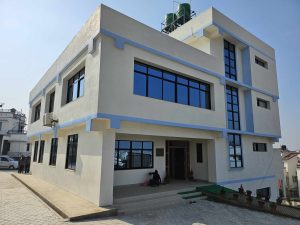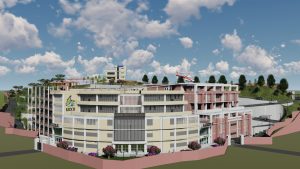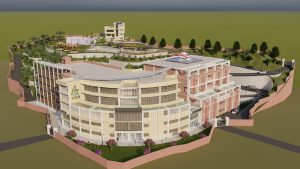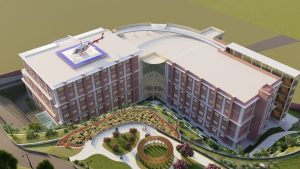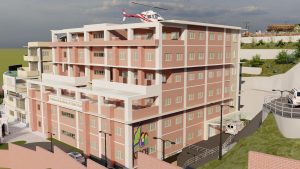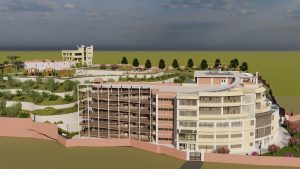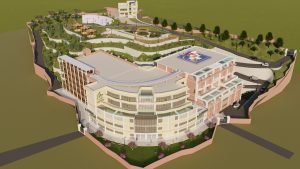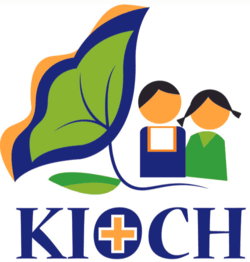PAEDIATRIC MULTI-SPECIALTY CARE CENTRE at KATHMANDU
In its initial phase, KIOCH will open the main pediatric specialty care facility in Budhanilkantha Municipality, Ward No. – 7, Kathmandu. The Government of Nepal has leased 41-10-3 Ropani (5.2 acres) of land. The facility will initially consist of the following main specialties: 1) Cardiology and Cardiothoracic surgery 2) Oncology, and 3) Mental Health, 4) Emergency services for children 5) Critical care, 6) Orthopedics and Trauma services. These specialties were chosen both based on the population needs and financial viability. In phase II more specialties and services will be included, and service or bed capacity will be adjusted according to the actual demand.
SPECIALTY RATIONALE
CARDIOLOGY AND CARDIOTHORACIC SURGERY
Rheumatic heart disease (RHD) is the most commonly acquired heart disease among children in Nepal. RHD is a chronic heart condition caused by acute rheumatic fever which can be prevented with proper treatment of throat/ear infections. RHD is among the top three reasons for admission into the cardiology department and second most common cause of cardiac surgery in Nepal. Congenital Heart Diseases (CHD) are prevalent in 1% of all live births and constitutes a significant volume of work for pediatric service.
ONCOLOGY
There are approximately 1-1.5 incidences of cancer per 10,000 children. Records from Kanti Children’s Hospital show that the current cure rate for cancer is around 40%, with 35% abandonment of therapy due to financial burden, and 25% mortality. With the modern treatment facilities the cure rate of pediatric cancers is much higher in the developed world.
MENTAL HEALTH
In Nepal, the estimated suicide rate for people aged 15-29 years in 2012 was 25.8 per 100,000. Among students aged 13-17 years, 10% attempted suicide one or more times, 14% made a plan about how they would attempt suicide, and 13.7% seriously considered suicide. It should be noted that the problem may be significantly underestimated due to stigma, social taboos, and systems for reporting suicide.
ORTHOPEDICS AND TRAUMA: Trauma and orthopedic issues are common problems among the children. Trauma also has one of the highest impoverishment impact of the common people of Nepal.
CRITICAL CARE
Critical care is common ground of care for all types of illnesses. All complex problems of children need to be treated in an intensely monitored and optimized setting using hi-tech equipment and skilled manpower. There are very limited numbers of critical care beds for children in this country. We intend to set up a state of the art intensive care for the neonates and older kids with trained Human resource.
EMERGENCY SERVICES AND PEDIATRIC GENERAL SURGERY
Most hospitals in Nepal would have a common Emergency for both adults and children. Catering to the acute needs of children of the community 24/7 is of critical importance. Early diagnosis and introduction of treatment by trained personnel gives the best chance for improvement of any serious illness. Our Emergency unit shall have well equipped resuscitation room, procedure room, an operation room for casualties, beds for monitoring and isolation beds for kids with communicable disease. The emergency room shall have direct access to the diagnostic services and to critical care if necessary.
LOCATION RATIONALE
Kathmandu Valley is one of the fastest-growing metropolitan areas in South Asia, growing at 4 percent per year. With a population of more than 2.5 million registered people, of which approximately 1 million are children, the available services in the Valley and the referral points for those outside the Valley are not sufficient, with only 475 beds available for specialized children’s care. Furthermore, the proximity to the Government, private sector, non-profit organizations will lead to better communication and collaboration. As KIOCH will be designed to become a model center of excellence, it needs interaction with other parties.
Doctors are unevenly distributed in Nepal. While the Kathmandu Valley has one doctor for 850 people, in rural areas of the country the ratio is one doctor for every 150,000 people. Nepal faces challenges in attracting more doctors and nurses to practice in rural areas or even stay in the country. Doctors feel that there are fewer opportunities for professional development in rural health facilities because of the inadequate equipment and training available. Therefore, most doctors either choose to practice in urban hospitals or migrate to other countries.
For these reasons described above, building the pediatric specialty care center in Kathmandu will prove to be more successful in attracting talented specialists, as well as connecting specialists to the distant rural areas of Nepal. Providers can continue to be based in Kathmandu and do occasional site visits to our satellite locations, and junior medical officers can complete away rotations in the satellite clinics. Additionally, the use of telemedicine will streamline all our care coordination efforts and bridge the gap in care even more. Our solution in Phase 1 allows for concentration of talent and sophisticated equipment or treatment in the hub facility located in the capital city. We can attract specialists as well as train or increase specialty skills because of the volume of cases.
Pediatric Specialty Care Centre in Bagmati Province
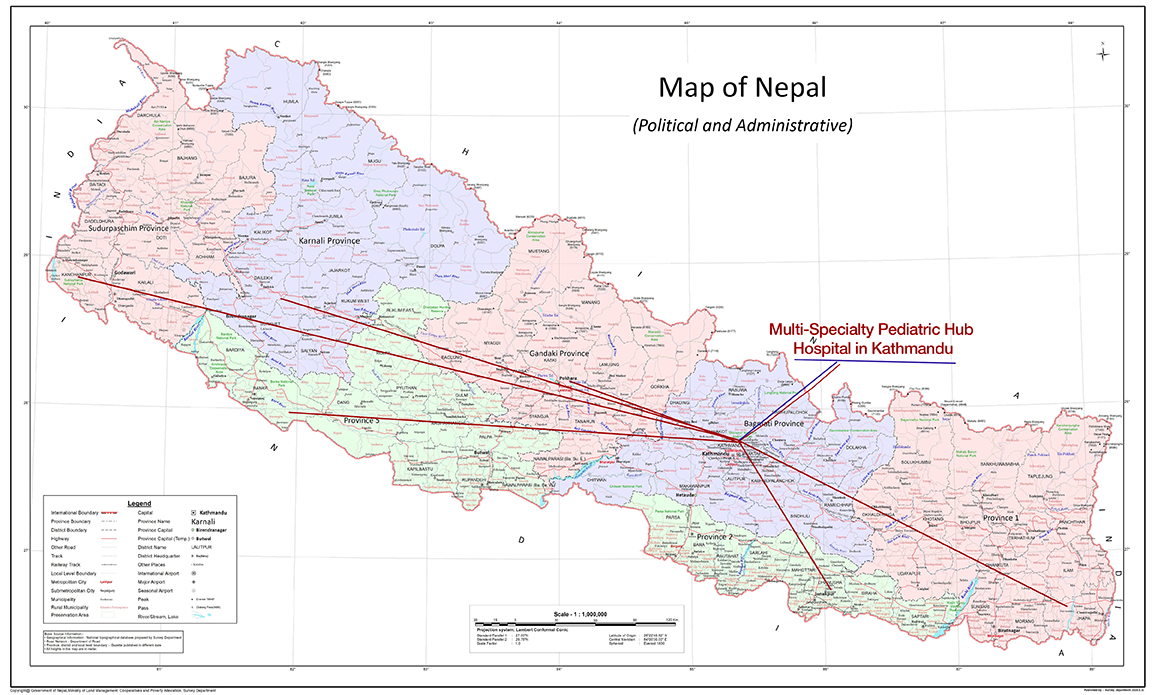
SERVICES AND DESIGN
KIOCH will follow all mandated guidelines for a pediatric tertiary hospital as required by the Ministry of Health and Population Quality Standards and Regulation Division. In addition to this, we will look for other ways to provide the best care and care experience possible. This will include other designated areas or amenities that will make the patient feel comfortable. In the detailed design, we will map out the patient journey in a way that is easy and convenient for families to follow. We will also incorporate systems that make hospital operations more efficient. Appendix C shows a more detailed listing of what departments and amenities will be incorporated into the detailed design for Phase 1.
Phase 1 and Phase 2 Services (phase 2 should have almost all programs)
Select services shall be started in phase I and by the time of phase II all major Specialties will be available which include but not limited to:
- General pediatric services
- Pulmonology/Immunology and ID
- Nephrology/ Urology and dialysis center
- Neurology and Neurosurgery
- General Pediatric and plastic Surgery
- Other services to be added gradually
Note: Services will be added on demand basis
Type of Services
TOTAL BEDS
Total beds planned for the hospital is 200; this will be implemented in two phases. Phase 1 will include 100 total beds. This includes Pediatric Intensive Care Unit (PICU), Neonatal Intensive Care Unit (NICU) Pediatric Surgical ICU (PSICU) with separate isolation rooms for infected patients or patients that are immunocompromised. The hospital will also have emergency department beds, general ward for patients, and private rooms. Special attention will be needed in creating the dedicated isolation rooms in the different departments as children are extremely susceptible to illness and infection. Phase two shall add another 100 beds in the listed specialties. The exact ratio of beds per department will be finalized during the detailed design phase.
OPERATING THEATERS
A total of 5 operating theaters (OT) will allow for maximum efficiency to increase patient throughput. Surgeons can cycle through operating theaters so that after they complete one surgery, they need only step into the next OT which will already be prepared for their next surgery. Meanwhile, the previous OT will be cleaned and prepared for the next patient. In a typical hospital surgery department, each surgeon is assigned an OT and works cases back to back with some turnover time in between each case. Alternatively, each OT can have a customized set up for specific types of procedures. KIOCH will find ways to work efficiently using parallel processing or conveyor belt methods, so that more patients can be treated.
One of the Operating Theatres shall be dedicated for septic patients. One of the performance-based indicators we will continue to evaluate is our Healthcare Associated Infection (HAI) rate, also known as hospital-acquired infection. HAI is associated with health complications and death, and lead to significant financial losses for the institution. This can be largely avoided with best practices in sterilization, but a dedicated OT can minimize the risk.
EMERGENCY DEPARTMENT
The Emergency Department (ED) will cater to emergency cardiac, cancer, and psychiatric cases. However, basic lifesaving and stabilization procedures will be conducted as a part of our medical oath and responsibility. Initially, it will be important to emphasize to the public that KIOCH is a specialty care center for children, and the ED must be reserved for severe cases. Additionally, the ED will have its own entrance, so as not to disrupt the main operational flow.
OUTPATIENT DEPARTMENT AND DAYCARE
As a multi-specialty care center, we provide holistic care by having a good coordination of different departments. The patient in need of specialty care can avail the care by coming to the OPD or through referral. However, we will provide emergency management for general cases. The Outpatient Department (OPD) will include diagnostic and lab services with a sampling collection area and consultation or examination rooms. There will also be a room or OT room dedicated to any minor procedures.
Daycare for cancer patients will be located adjacent to the OPD but also accessible through a separate entrance from the outside. The concept behind this is to make it easy for the patient’s family to go directly to Daycare, since some children may need to receive chemotherapy as frequently as every day. If the family wishes to check in with their doctor, they do not have to go through the main reception area and waiting process. Similarly, the doctor can easily check in with their patients in Daycare.
INPATIENT SERVICES
Each department will have inpatient services that will consist of a clinical ward, isolation rooms, and ICU (Neonatal and Pediatric). KIOCH will provide full-time inpatient coverage with specialists and medical staff rotating on and off service. We will have a quality performance team dedicated to measuring morbidity and mortality rates, infection rates, and patient satisfaction with inpatient services. KIOCH will also focus on performance measures such as Average Length of Stay (ALOS) to keep costs low for the patient and KIOCH. A sub-acute care ward is for patients who only need low-intensive care thereby freeing up more acute beds for those who need it. We will decide if the sub-acute care ward will be a separate block during the detailed design phase.
BLOOD BANK
Blood bank services will be essential to care provided by KIOCH. The blood bank will have the capability of producing different components using a separation technology. Cancer patients frequently require blood transfusions; therefore, inventory and stock of blood must be managed. Furthermore, having a blood bank serves as rapid response to urgent or emergency cases requiring blood or blood components. A blood bank can also serve the needs of hospitals nearby that cannot access Red Cross blood banks or in cases of blood type shortages.
OTHER SUPPORT SERVICES
This includes laboratory facilities and the radiology services. All other services, required by the Ministry of Health for the specialized hospital shall also be developed.
CRITICAL CARE
Critical care is common ground of care for all types of illnesses. All complex problems of children need to be treated in an intensely monitored and optimized setting using hi-tech equipment and skilled manpower. There are very limited numbers of critical care beds for children in this country. We intend to set up a state of the art intensive care for the neonates and older kids with trained Human resource.EMERGENCY SERVICES AND PEDIATRIC GENERAL SURGERY
Most hospitals in Nepal would have a common Emergency for both adults and children. Catering to the acute needs of children of the community 24/7 is of critical importance. Early diagnosis and introduction of treatment by trained personnel gives the best chance for improvement of any serious illness. Our Emergency unit shall have well equipped resuscitation room, procedure room, an operation room for casualties, beds for monitoring and isolation beds for kids with communicable disease. The emergency room shall have direct access to the diagnostic services and to critical care if necessary.LOCATION RATIONALE
Kathmandu Valley is one of the fastest-growing metropolitan areas in South Asia, growing at 4 percent per year. With a population of more than 2.5 million registered people, of which approximately 1 million are children, the available services in the Valley and the referral points for those outside the Valley are not sufficient, with only 475 beds available for specialized children’s care. Furthermore, the proximity to the Government, private sector, non-profit organizations will lead to better communication and collaboration. As KIOCH will be designed to become a model center of excellence, it needs interaction with other parties. Doctors are unevenly distributed in Nepal. While the Kathmandu Valley has one doctor for 850 people, in rural areas of the country the ratio is one doctor for every 150,000 people. Nepal faces challenges in attracting more doctors and nurses to practice in rural areas or even stay in the country. Doctors feel that there are fewer opportunities for professional development in rural health facilities because of the inadequate equipment and training available. Therefore, most doctors either choose to practice in urban hospitals or migrate to other countries. For these reasons described above, building the pediatric specialty care center in Kathmandu will prove to be more successful in attracting talented specialists, as well as connecting specialists to the distant rural areas of Nepal. Providers can continue to be based in Kathmandu and do occasional site visits to our satellite locations, and junior medical officers can complete away rotations in the satellite clinics. Additionally, the use of telemedicine will streamline all our care coordination efforts and bridge the gap in care even more. Our solution in Phase 1 allows for concentration of talent and sophisticated equipment or treatment in the hub facility located in the capital city. We can attract specialists as well as train or increase specialty skills because of the volume of cases.
SERVICES AND DESIGN
KIOCH will follow all mandated guidelines for a pediatric tertiary hospital as required by the Ministry of Health and Population Quality Standards and Regulation Division. In addition to this, we will look for other ways to provide the best care and care experience possible. This will include other designated areas or amenities that will make the patient feel comfortable. In the detailed design, we will map out the patient journey in a way that is easy and convenient for families to follow. We will also incorporate systems that make hospital operations more efficient. Appendix C shows a more detailed listing of what departments and amenities will be incorporated into the detailed design for Phase 1. Phase 1 and Phase 2 Services (phase 2 should have almost all programs) Select services shall be started in phase I and by the time of phase II all major Specialties will be available which include but not limited to:
Select services shall be started in phase I and by the time of phase II all major Specialties will be available which include but not limited to:
- General pediatric services
- Pulmonology/Immunology and ID
- Nephrology/ Urology and dialysis center
- Neurology and Neurosurgery
- General Pediatric and plastic Surgery
- Other services to be added gradually
- Note: Services will be added on demand basis
